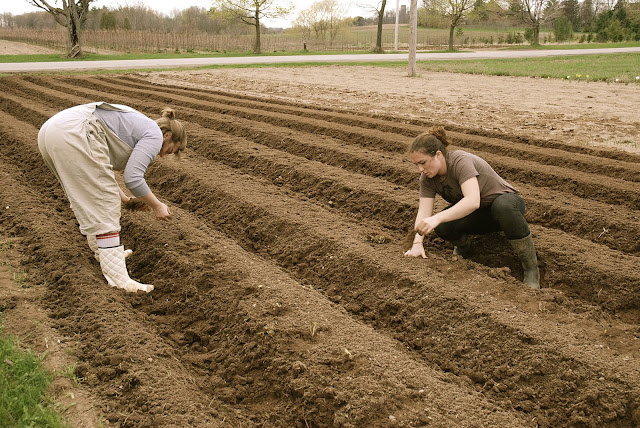It was a beautiful weekend full of activity. Saturday afternoon, Kate, Erick and I attended some Doors Open Hamilton locations - Dundurn National Historic Site - specifically the William Reid Cottage, and the Kitchen Garden, as well as the Mohawk Trail School House (but I'll save that for later!). We would have liked to go inside the Castle but the line up extended out the door and around the corner. We were impatient and did not want to queue.
 |
| Sir Allan MacNab's very own cock-fighting pit. |
Dundurn, the home of Sir Allan Napier MacNab (one of Canada's first premiers), was one of my favourite historic sites to visit as a child. Our family vacations were always educational, comprised of trips to museums, historic homes, forts, archaeological sites, natural wonders and pioneer villages, but Dundurn Castle was my hometown historical house and I am so familiar with it that I could probably give a guided tour of it myself. My favourite part of the house as a child was upstairs with all its finery, but I am now more interested in the below stairs part of the house, with its kitchen, laundry, scullery and food stores.
 |
| A dormant, not yet in bloom, hedge of lavender. |
In recent years, there has been an exciting addition to Dundurn as they have begun to restore the Kitchen Garden, and there are plans to begin restoration on the home of the head gardener, William Reid. The garden is a wonderful place to visit at almost any time of year, because it is always in continuous state of growth and flux.
 |
| The garden pump. |
They have been carefully recreating the garden based on historical research, and populating it with heirloom and historical plants. Last fall when I visited the garden, I was surprised to discover that the Victorians were growing such diverse foods such as ground cherry and tomatillo. Exciting things were happening this spring. The Victorians preferred to eat their asparagus white, and would blanch them under specially-woven baskets stuffed with straw.
The Victorians did as much as they could to extend the growing season for fresh produce, employing cold frames and greenhouses. They built hothouses where they grew cucumbers, peaches and pineapples indoors. Many years ago, I remember watching a series on TVOntario, The Victorian Kitchen Garden, that documented the recreation of an English Victorian estate garden, and the astounding measures that gardeners undertook to put food on the tables of the great houses. It was an era when a gardener could be dismissed for sending an unripe melon to the dining room!
I am increasingly interested in historic practices of housekeeping and gardening and how these activities can contrast with contemporary approaches. There is so much to be learned from how things were done, with such ingenuity, in days long ago. I will be posting further here, and on the Beehive, about the Kitchen Garden, and the activities below stairs at Dundurn.
From Doors Open to our very own gardening venture, up at the Buttrum farm. It was Kate and Erick's first time up to the farm, and they plunged right in. We worked hard for a few hours, finishing Gabby and Courtney's work planting strawberries, and then planting 150 rhubarb plants. Rhubarb and strawberries are both perennials, and will take at least a season to get established before we can begin harvesting. Strawberry rhubarb pie and jam will have to wait a while.
Planting the tiny strawberry plants involves making a hole in the earth with your hand, tucking in the plant and gently but firmly, closing in the soil around the strawberry's roots. This was made easy, as the soil at the Buttrum's farm is sandy, loamy and very soft, perfect for growing vegetables!
I took a few rhubarb roots home with me, where I will add them to my backyard patch. Rhubarb roots are bizarre looking, but a very useful part of the plant. Rhubarb leaves and roots are rich in oxalic acid, which is poisonous, but also a good mordant and dye for natural dyeing! You can also use oxalic acid to make your own cleaning solutions...
We spent Sunday at the farm planting onion sets for bunching onions, and I also finally harvested my forced rhubarb and made a lovely stewed rhubarb for Mother's day dessert, which I will post about tomorrow!











thanks for sharing these photos of the kitchen garden. You would probably enjoy the BBC series Edwardian Farm. It's pretty awesome. http://www.youtube.com/watch?v=qFjdpu4QoLo
ReplyDeleteThanks a lot for sharing. Keep blogging
ReplyDeletePoppy